An overview of the gasohol market in Vietnam, the next direction?
To ensure energy security, reduce greenhouse gas emissions and increase agricultural output, the Vietnamese government has issued several policies to promote gasohol, resulting in remarkable achievements in gasohol development in recent years. However, unexpected limitations have been seen by other countries after a period of using this fuel such as air pollution, threats to food security, deterioration of natural forest area and severely depleted freshwater resources. This paper presents an overview of the current state of Vietnam's gasohol market and a brief analysis of policy, supply - Demand - price information, from which some hindrances are identified and a few more optimistic directions to develop this type of fuel in the future are proposed
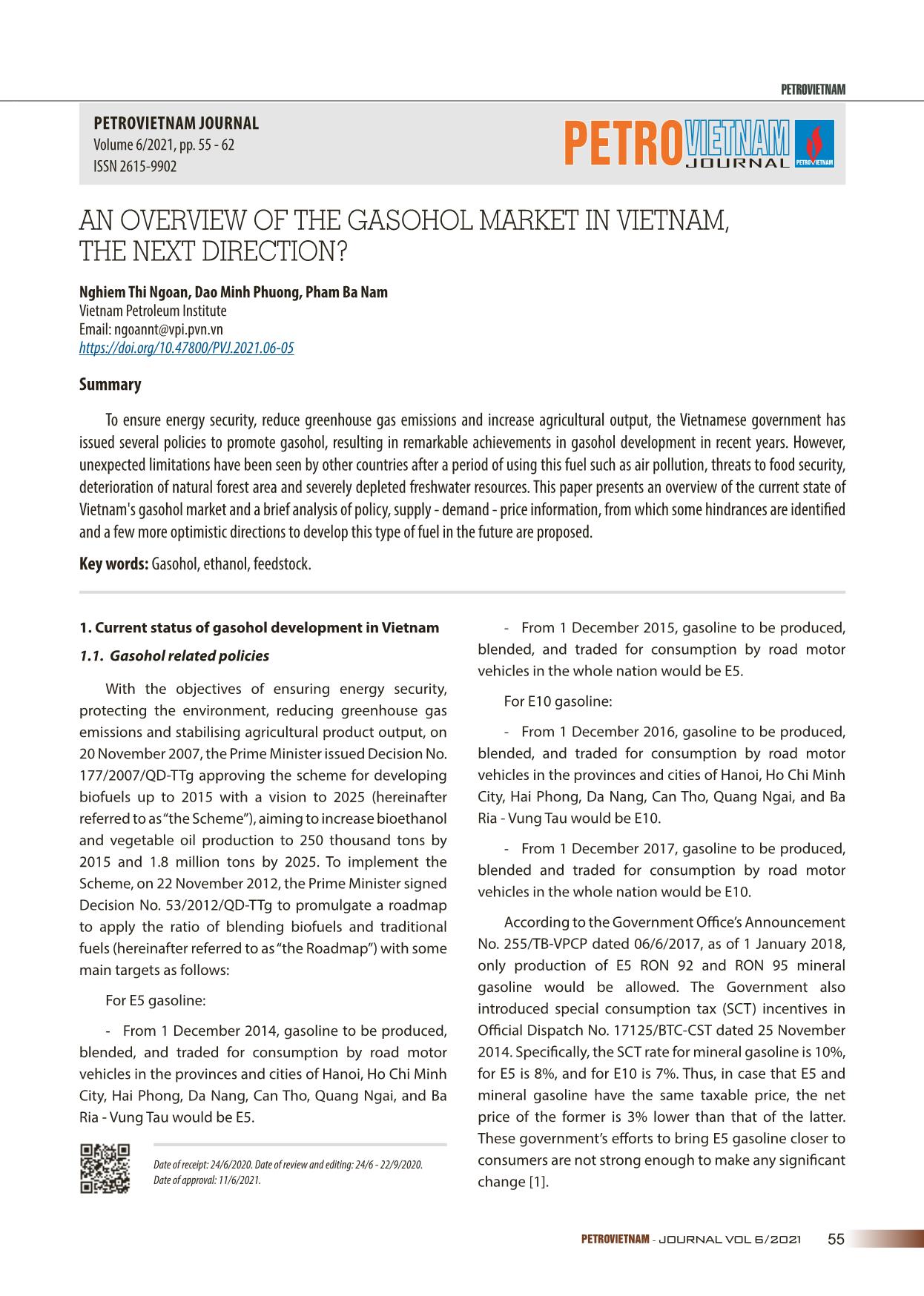
Trang 1

Trang 2
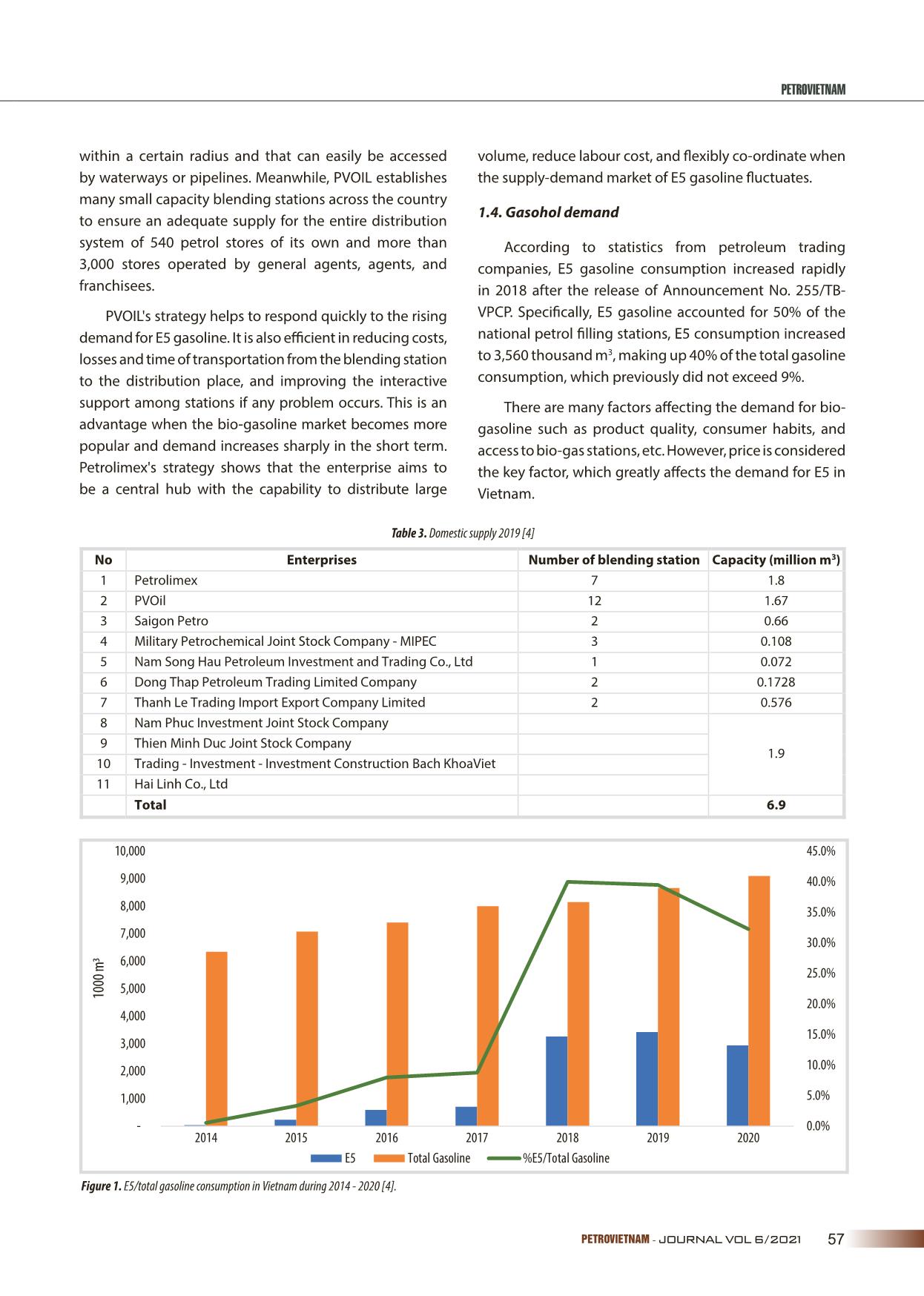
Trang 3
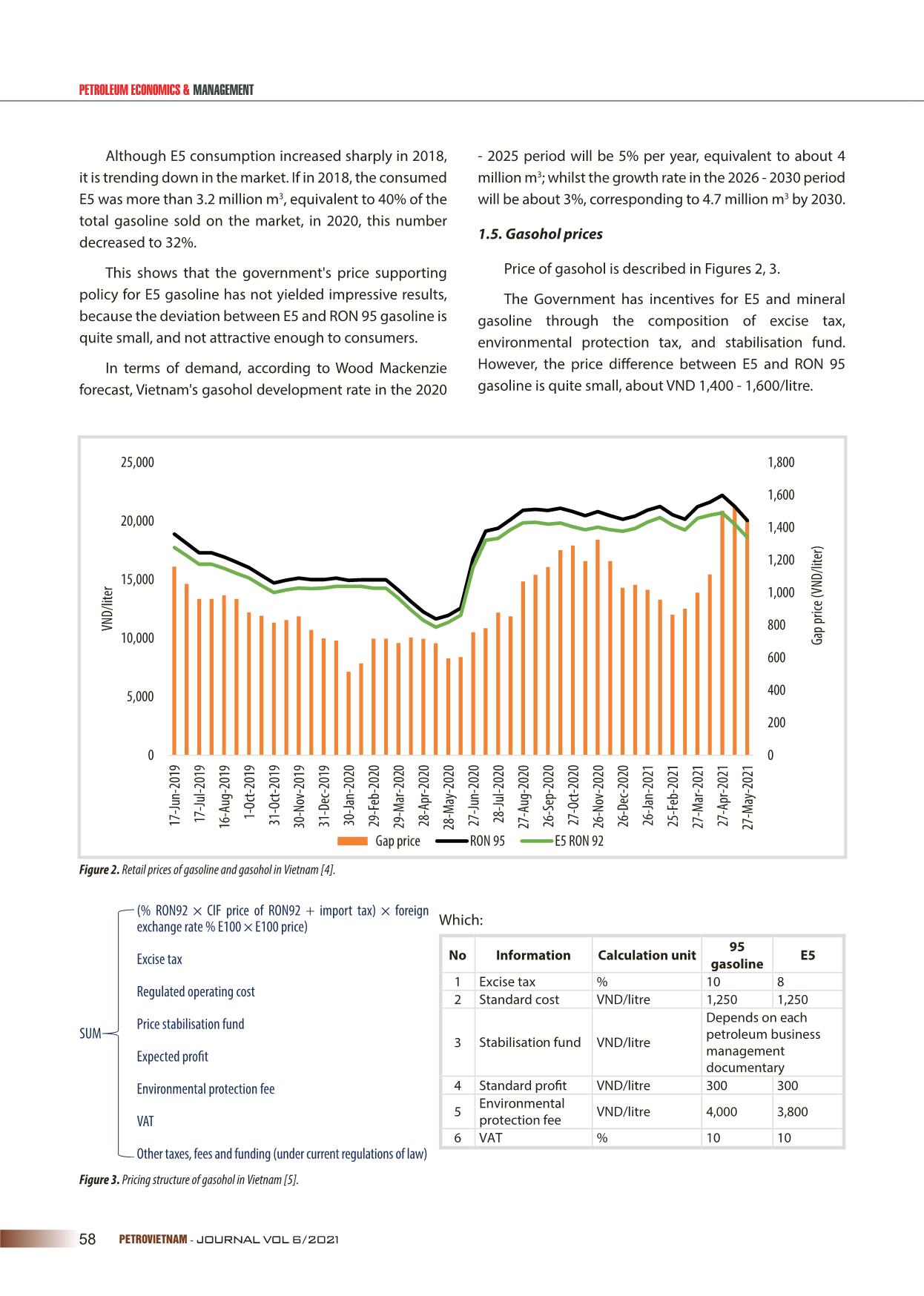
Trang 4
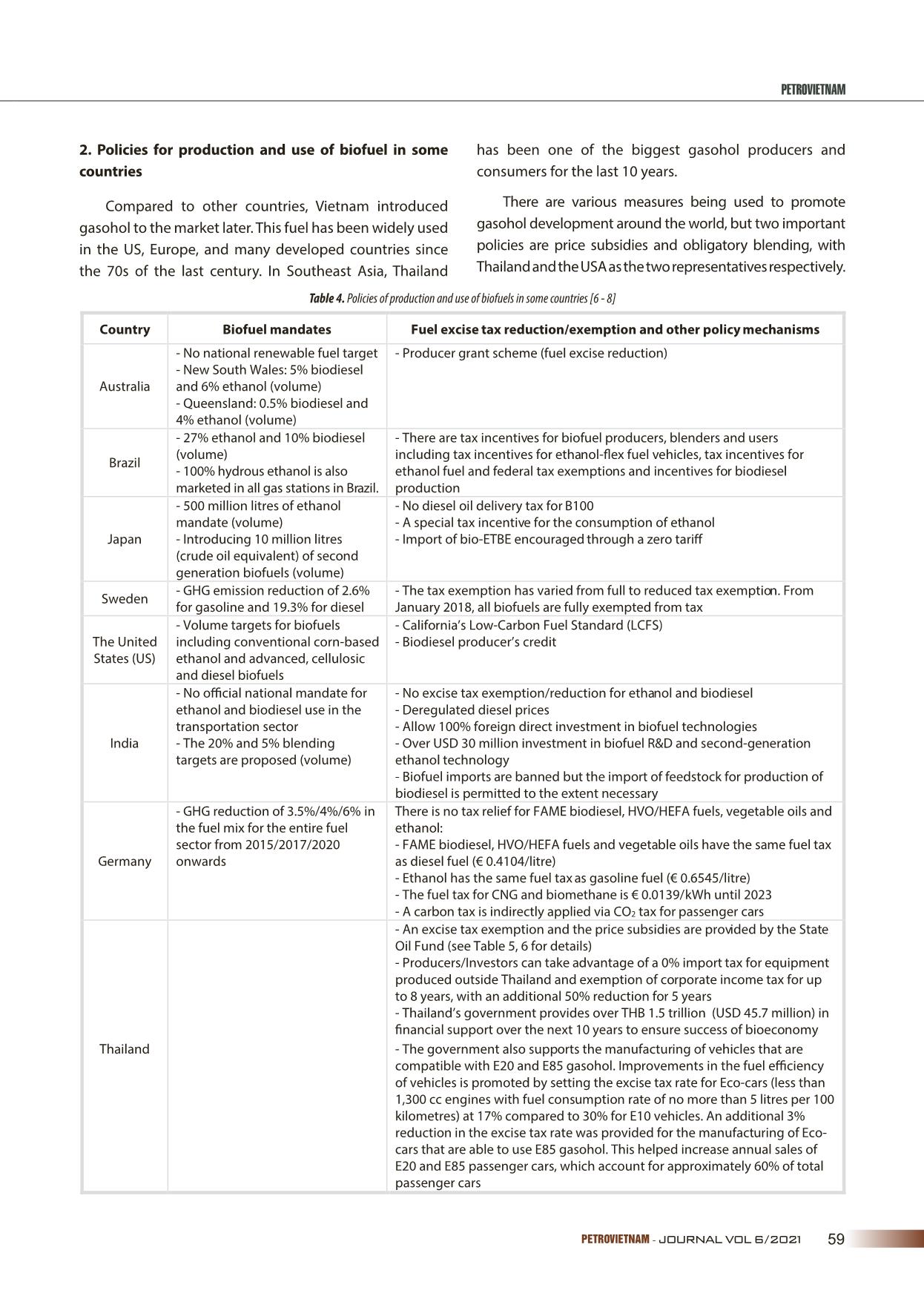
Trang 5
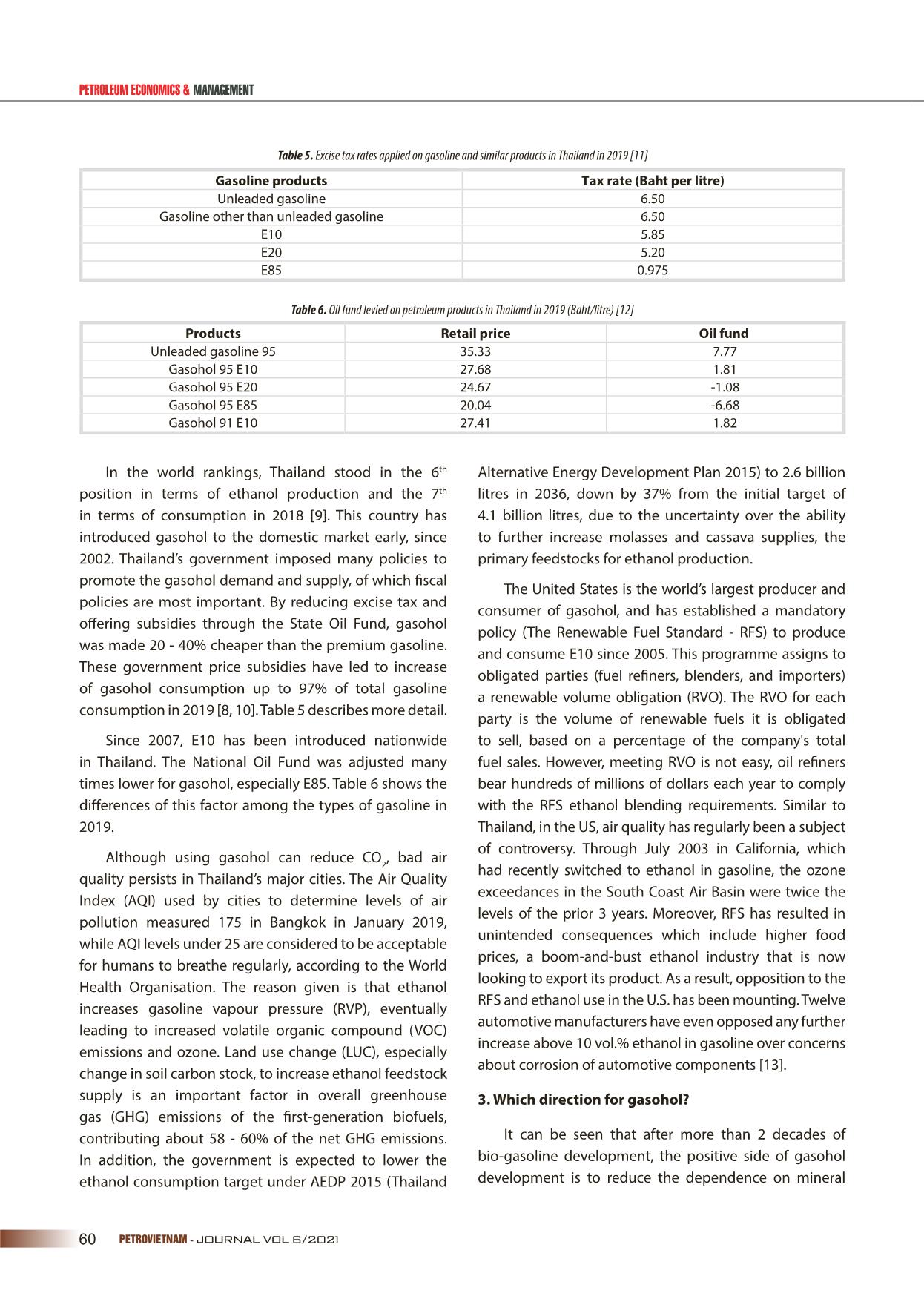
Trang 6
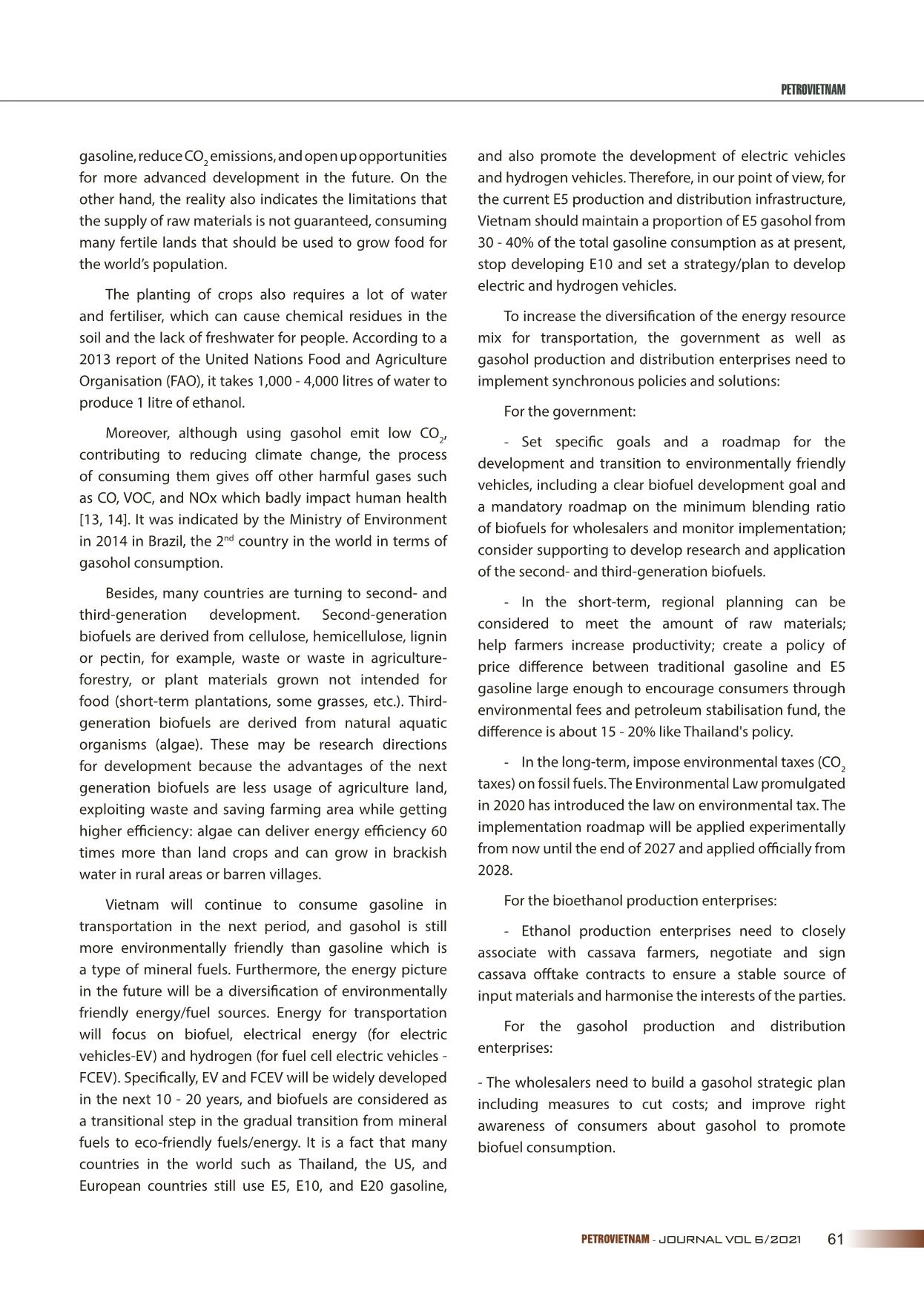
Trang 7
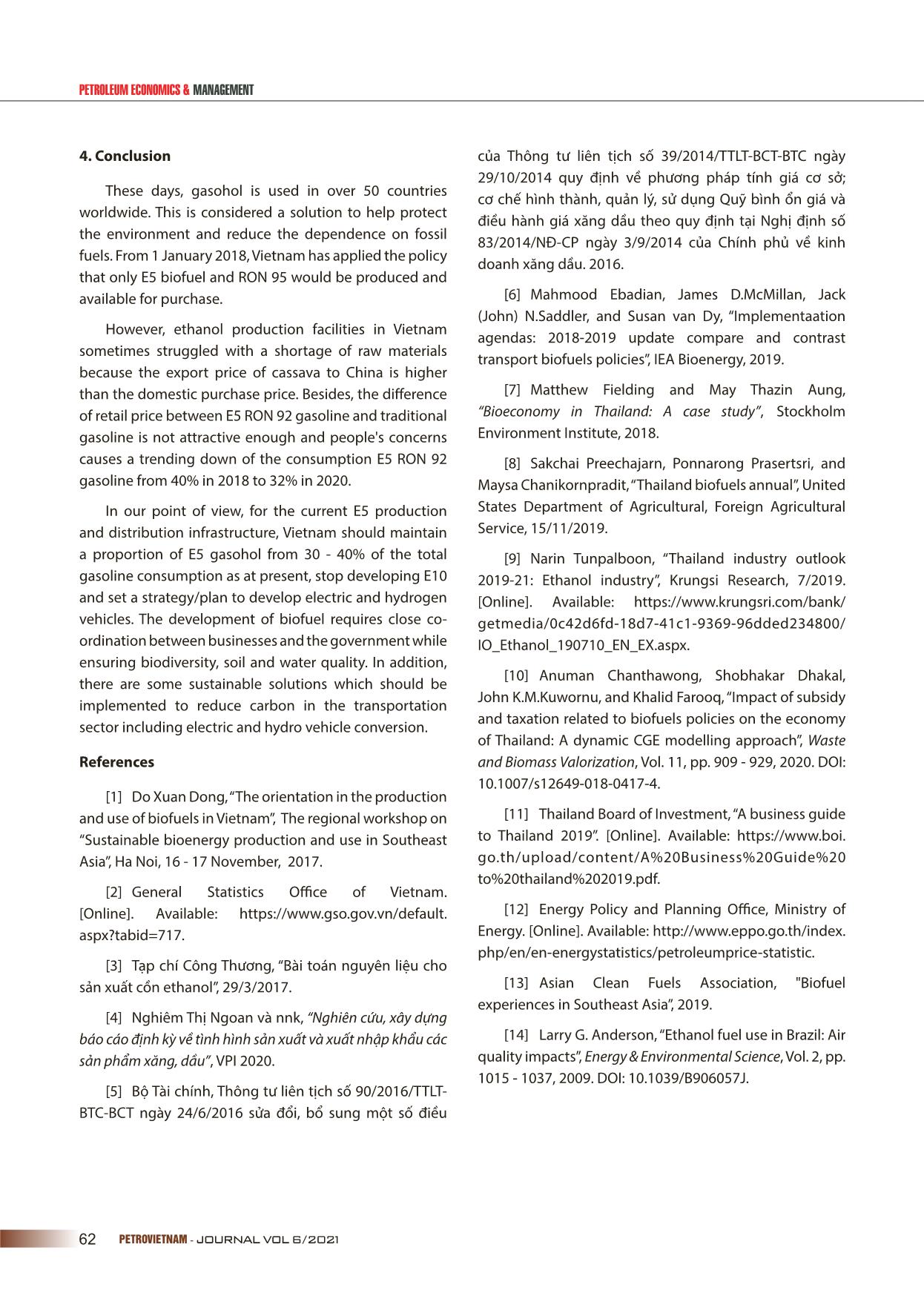
Trang 8
Tóm tắt nội dung tài liệu: An overview of the gasohol market in Vietnam, the next direction?
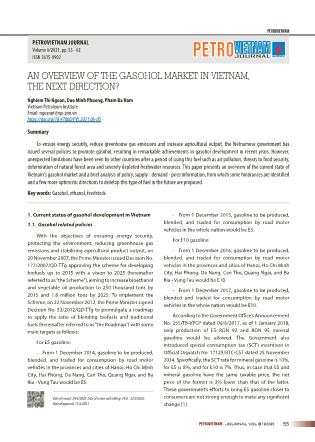
ng - Over USD 30 million investment in biofuel R&D and second-generation targets are proposed (volume) ethanol technology - Biofuel imports are banned but the import of feedstock for production of biodiesel is permitted to the extent necessary - GHG reduction of 3.5%/4%/6% in There is no tax relief for FAME biodiesel, HVO/HEFA fuels, vegetable oils and the fuel mix for the entire fuel ethanol: sector from 2015/2017/2020 - FAME biodiesel, HVO/HEFA fuels and vegetable oils have the same fuel tax Germany onwards as diesel fuel (€ 0.4104/litre) - Ethanol has the same fuel tax as gasoline fuel (€ 0.6545/litre) - The fuel tax for CNG and biomethane is € 0.0139/kWh until 2023 - A carbon tax is indirectly applied via CO2 tax for passenger cars - An excise tax exemption and the price subsidies are provided by the State Oil Fund (see Table 5, 6 for details) - Producers/Investors can take advantage of a 0% import tax for equipment produced outside Thailand and exemption of corporate income tax for up to 8 years, with an additional 50% reduction for 5 years - Thailand’s government provides over THB 1.5 trillion (USD 45.7 million) in nancial support over the next 10 years to ensure success of bioeconomy Thailand - The government also supports the manufacturing of vehicles that are compatible with E20 and E85 gasohol. Improvements in the fuel e ciency of vehicles is promoted by setting the excise tax rate for Eco-cars (less than 1,300 cc engines with fuel consumption rate of no more than 5 litres per 100 kilometres) at 17% compared to 30% for E10 vehicles. An additional 3% reduction in the excise tax rate was provided for the manufacturing of Eco- cars that are able to use E85 gasohol. This helped increase annual sales of E20 and E85 passenger cars, which account for approximately 60% of total passenger cars PETROVIETNAM - JOURNAL VOL 6/2021 59 PETROLEUM ECONOMICS & MANAGEMENT Table 5. Excise tax rates applied on gasoline and similar products in Thailand in 2019 [11] Gasoline products Tax rate (Baht per litre) Unleaded gasoline 6.50 Gasoline other than unleaded gasoline 6.50 E10 5.85 E20 5.20 E85 0.975 Table 6. Oil fund levied on petroleum products in Thailand in 2019 (Baht/litre) [12] Products Retail price Oil fund Unleaded gasoline 95 35.33 7.77 Gasohol 95 E10 27.68 1.81 Gasohol 95 E20 24.67 -1.08 Gasohol 95 E85 20.04 -6.68 Gasohol 91 E10 27.41 1.82 In the world rankings, Thailand stood in the 6th Alternative Energy Development Plan 2015) to 2.6 billion position in terms of ethanol production and the 7th litres in 2036, down by 37% from the initial target of in terms of consumption in 2018 [9]. This country has 4.1 billion litres, due to the uncertainty over the ability introduced gasohol to the domestic market early, since to further increase molasses and cassava supplies, the 2002. Thailand’s government imposed many policies to primary feedstocks for ethanol production. promote the gasohol demand and supply, of which fiscal The United States is the world’s largest producer and policies are most important. By reducing excise tax and consumer of gasohol, and has established a mandatory offering subsidies through the State Oil Fund, gasohol policy (The Renewable Fuel Standard - RFS) to produce was made 20 - 40% cheaper than the premium gasoline. and consume E10 since 2005. This programme assigns to These government price subsidies have led to increase obligated parties (fuel refiners, blenders, and importers) of gasohol consumption up to 97% of total gasoline a renewable volume obligation (RVO). The RVO for each consumption in 2019 [8, 10]. Table 5 describes more detail. party is the volume of renewable fuels it is obligated Since 2007, E10 has been introduced nationwide to sell, based on a percentage of the company's total in Thailand. The National Oil Fund was adjusted many fuel sales. However, meeting RVO is not easy, oil refiners times lower for gasohol, especially E85. Table 6 shows the bear hundreds of millions of dollars each year to comply differences of this factor among the types of gasoline in with the RFS ethanol blending requirements. Similar to 2019. Thailand, in the US, air quality has regularly been a subject of controversy. Through July 2003 in California, which Although using gasohol can reduce CO , bad air 2 had recently switched to ethanol in gasoline, the ozone quality persists in Thailand’s major cities. The Air Quality exceedances in the South Coast Air Basin were twice the Index (AQI) used by cities to determine levels of air levels of the prior 3 years. Moreover, RFS has resulted in pollution measured 175 in Bangkok in January 2019, unintended consequences which include higher food while AQI levels under 25 are considered to be acceptable prices, a boom-and-bust ethanol industry that is now for humans to breathe regularly, according to the World looking to export its product. As a result, opposition to the Health Organisation. The reason given is that ethanol RFS and ethanol use in the U.S. has been mounting. Twelve increases gasoline vapour pressure (RVP), eventually automotive manufacturers have even opposed any further leading to increased volatile organic compound (VOC) increase above 10 vol.% ethanol in gasoline over concerns emissions and ozone. Land use change (LUC), especially about corrosion of automotive components [13]. change in soil carbon stock, to increase ethanol feedstock supply is an important factor in overall greenhouse 3. Which direction for gasohol? gas (GHG) emissions of the first-generation biofuels, contributing about 58 - 60% of the net GHG emissions. It can be seen that after more than 2 decades of In addition, the government is expected to lower the bio-gasoline development, the positive side of gasohol ethanol consumption target under AEDP 2015 (Thailand development is to reduce the dependence on mineral 60 PETROVIETNAM - JOURNAL VOL 6/2021 PETROVIETNAM gasoline, reduce CO2 emissions, and open up opportunities and also promote the development of electric vehicles for more advanced development in the future. On the and hydrogen vehicles. Therefore, in our point of view, for other hand, the reality also indicates the limitations that the current E5 production and distribution infrastructure, the supply of raw materials is not guaranteed, consuming Vietnam should maintain a proportion of E5 gasohol from many fertile lands that should be used to grow food for 30 - 40% of the total gasoline consumption as at present, the world’s population. stop developing E10 and set a strategy/plan to develop electric and hydrogen vehicles. The planting of crops also requires a lot of water and fertiliser, which can cause chemical residues in the To increase the diversification of the energy resource soil and the lack of freshwater for people. According to a mix for transportation, the government as well as 2013 report of the United Nations Food and Agriculture gasohol production and distribution enterprises need to Organisation (FAO), it takes 1,000 - 4,000 litres of water to implement synchronous policies and solutions: produce 1 litre of ethanol. For the government: Moreover, although using gasohol emit low CO , 2 - Set specific goals and a roadmap for the contributing to reducing climate change, the process development and transition to environmentally friendly of consuming them gives off other harmful gases such vehicles, including a clear biofuel development goal and as CO, VOC, and NOx which badly impact human health a mandatory roadmap on the minimum blending ratio [13, 14]. It was indicated by the Ministry of Environment of biofuels for wholesalers and monitor implementation; in 2014 in Brazil, the 2nd country in the world in terms of consider supporting to develop research and application gasohol consumption. of the second- and third-generation biofuels. Besides, many countries are turning to second- and - In the short-term, regional planning can be third-generation development. Second-generation considered to meet the amount of raw materials; biofuels are derived from cellulose, hemicellulose, lignin help farmers increase productivity; create a policy of or pectin, for example, waste or waste in agriculture- price difference between traditional gasoline and E5 forestry, or plant materials grown not intended for gasoline large enough to encourage consumers through food (short-term plantations, some grasses, etc.). Third- environmental fees and petroleum stabilisation fund, the generation biofuels are derived from natural aquatic difference is about 15 - 20% like Thailand's policy. organisms (algae). These may be research directions for development because the advantages of the next - In the long-term, impose environmental taxes (CO2 generation biofuels are less usage of agriculture land, taxes) on fossil fuels. The Environmental Law promulgated exploiting waste and saving farming area while getting in 2020 has introduced the law on environmental tax. The higher efficiency: algae can deliver energy efficiency 60 implementation roadmap will be applied experimentally times more than land crops and can grow in brackish from now until the end of 2027 and applied officially from water in rural areas or barren villages. 2028. Vietnam will continue to consume gasoline in For the bioethanol production enterprises: transportation in the next period, and gasohol is still - Ethanol production enterprises need to closely more environmentally friendly than gasoline which is associate with cassava farmers, negotiate and sign a type of mineral fuels. Furthermore, the energy picture cassava offtake contracts to ensure a stable source of in the future will be a diversification of environmentally input materials and harmonise the interests of the parties. friendly energy/fuel sources. Energy for transportation For the gasohol production and distribution will focus on biofuel, electrical energy (for electric enterprises: vehicles-EV) and hydrogen (for fuel cell electric vehicles - FCEV). Specifically, EV and FCEV will be widely developed - The wholesalers need to build a gasohol strategic plan in the next 10 - 20 years, and biofuels are considered as including measures to cut costs; and improve right a transitional step in the gradual transition from mineral awareness of consumers about gasohol to promote fuels to eco-friendly fuels/energy. It is a fact that many biofuel consumption. countries in the world such as Thailand, the US, and European countries still use E5, E10, and E20 gasoline, PETROVIETNAM - JOURNAL VOL 6/2021 61 PETROLEUM ECONOMICS & MANAGEMENT 4. Conclusion của Thông tư liên tịch số 39/2014/TTLT-BCT-BTC ngày 29/10/2014 quy định về phương pháp tính giá cơ sở; These days, gasohol is used in over 50 countries cơ chế hình thành, quản lý, sử dụng Quỹ bình ổn giá và worldwide. This is considered a solution to help protect điều hành giá xăng dầu theo quy định tại Nghị định số the environment and reduce the dependence on fossil 83/2014/NĐ-CP ngày 3/9/2014 của Chính phủ về kinh fuels. From 1 January 2018, Vietnam has applied the policy doanh xăng dầu. 2016. that only E5 biofuel and RON 95 would be produced and available for purchase. [6] Mahmood Ebadian, James D.McMillan, Jack (John) N.Saddler, and Susan van Dy, “Implementaation However, ethanol production facilities in Vietnam agendas: 2018-2019 update compare and contrast sometimes struggled with a shortage of raw materials transport biofuels policies”, IEA Bioenergy, 2019. because the export price of cassava to China is higher than the domestic purchase price. Besides, the difference [7] Matthew Fielding and May Thazin Aung, of retail price between E5 RON 92 gasoline and traditional “Bioeconomy in Thailand: A case study”, Stockholm gasoline is not attractive enough and people's concerns Environment Institute, 2018. causes a trending down of the consumption E5 RON 92 [8] Sakchai Preechajarn, Ponnarong Prasertsri, and gasoline from 40% in 2018 to 32% in 2020. Maysa Chanikornpradit, “Thailand biofuels annual”, United In our point of view, for the current E5 production States Department of Agricultural, Foreign Agricultural and distribution infrastructure, Vietnam should maintain Service, 15/11/2019. a proportion of E5 gasohol from 30 - 40% of the total [9] Narin Tunpalboon, “Thailand industry outlook gasoline consumption as at present, stop developing E10 2019-21: Ethanol industry”, Krungsi Research, 7/2019. and set a strategy/plan to develop electric and hydrogen [Online]. Available: https://www.krungsri.com/bank/ vehicles. The development of biofuel requires close co- getmedia/0c42d6fd-18d7-41c1-9369-96dded234800/ ordination between businesses and the government while IO_Ethanol_190710_EN_EX.aspx. ensuring biodiversity, soil and water quality. In addition, [10] Anuman Chanthawong, Shobhakar Dhakal, there are some sustainable solutions which should be John K.M.Kuwornu, and Khalid Farooq, “Impact of subsidy implemented to reduce carbon in the transportation and taxation related to biofuels policies on the economy sector including electric and hydro vehicle conversion. of Thailand: A dynamic CGE modelling approach”, Waste References and Biomass Valorization, Vol. 11, pp. 909 - 929, 2020. DOI: 10.1007/s12649-018-0417-4. [1] Do Xuan Dong, “The orientation in the production and use of biofuels in Vietnam”, The regional workshop on [11] Thailand Board of Investment, “A business guide “Sustainable bioenergy production and use in Southeast to Thailand 2019”. [Online]. Available: https://www.boi. Asia”, Ha Noi, 16 - 17 November, 2017. go.th/upload/content/A%20Business%20Guide%20 to%20thailand%202019.pdf. [2] General Statistics Office of Vietnam. [Online]. Available: https://www.gso.gov.vn/default. [12] Energy Policy and Planning Office, Ministry of aspx?tabid=717. Energy. [Online]. Available: php/en/en-energystatistics/petroleumprice-statistic. [3] Tạp chí Công Thương, “Bài toán nguyên liệu cho sản xuất cồn ethanol”, 29/3/2017. [13] Asian Clean Fuels Association, "Biofuel experiences in Southeast Asia”, 2019. [4] Nghiêm Thị Ngoan và nnk, “Nghiên cứu, xây dựng báo cáo định kỳ về tình hình sản xuất và xuất nhập khẩu các [14] Larry G. Anderson, “Ethanol fuel use in Brazil: Air sản phẩm xăng, dầu”, VPI 2020. quality impacts”, Energy & Environmental Science, Vol. 2, pp. 1015 - 1037, 2009. DOI: 10.1039/B906057J. [5] Bộ Tài chính, Thông tư liên tịch số 90/2016/TTLT- BTC-BCT ngày 24/6/2016 sửa đổi, bổ sung một số điều 62 PETROVIETNAM - JOURNAL VOL 6/2021
File đính kèm:
 an_overview_of_the_gasohol_market_in_vietnam_the_next_direct.pdf
an_overview_of_the_gasohol_market_in_vietnam_the_next_direct.pdf

